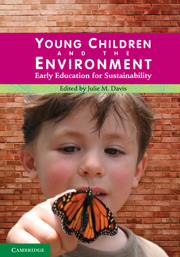Book contents
- Frontmatter
- Foreword
- Contents
- List of contributors
- Introduction
- PART 1
- Chapter 1 What is early childhood education for sustainability?
- Chapter 2 Children in the natural world
- Chapter 3 Leadership for creating cultures of sustainability
- Chapter 4 Practical possibilities and pedagogical approaches for early childhood education for sustainability
- Chapter 5 Ethics and pedagogy at the heart of early childhood education for sustainability
- PART 2
- Endnote
- Index
- References
Chapter 1 - What is early childhood education for sustainability?
from PART 1
- Frontmatter
- Foreword
- Contents
- List of contributors
- Introduction
- PART 1
- Chapter 1 What is early childhood education for sustainability?
- Chapter 2 Children in the natural world
- Chapter 3 Leadership for creating cultures of sustainability
- Chapter 4 Practical possibilities and pedagogical approaches for early childhood education for sustainability
- Chapter 5 Ethics and pedagogy at the heart of early childhood education for sustainability
- PART 2
- Endnote
- Index
- References
Summary
EDITOR'S NOTE
In this chapter, Julie Davis canvasses the literature to explain why sustainability issues are important for young children and why early childhood educators should become engaged with EfS. She outlines the short history of ECEfS in Australasia and internationally, emphasising its marginalised and fragile early phase that is now beginning to coalesce into a robust international movement. She then highlights two recent studies undertaken in child care centres that illustrate the learning and actions that are possible when education for sustainability is incorporated into early childhood curriculum and pedagogy.
Julie ends the chapter by identifying the qualities that might characterise early childhood education for sustainability, stressing its requirement to be transformative education that builds the capabilities of young children as agents of change for sustainability. In so doing, she draws together theoretical strands from both early childhood education and EfS, beginning the process of constructing a theoretical framework for ECEfS.
If you are thinking a year ahead, sow a seed.
If you are thinking ten years ahead, plant a tree.
If you are thinking a hundred years ahead, educate the people.
(Chinese poet Kuan Tzu, 500 BC)INTRODUCTION
Maybe I could be the water hero guy and save water!
(4-year-old child, 2007)The quote immediately above was a 4-year-old's response to a water education program conducted in a child care centre in northern New South Wales, Australia in 2007.
- Type
- Chapter
- Information
- Young Children and the EnvironmentEarly Education for Sustainability, pp. 21 - 42Publisher: Cambridge University PressPrint publication year: 2010
References
- 30
- Cited by



